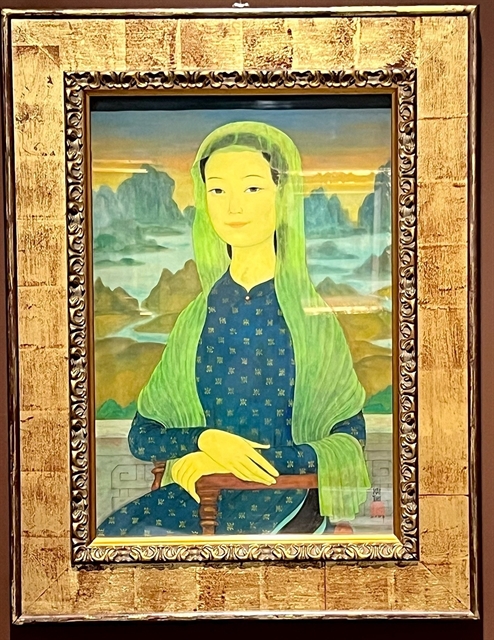A Smile Through a New Lens is how researchers describe the Mona Lisa (1974) by artist Mai Trung Thứ. Completed at the age of 68, this Mona Lisa is the third and largest reinterpretation of Leonardo da Vinci’s original masterpiece.

Mai Trung Thứ's third and largest reinterpretation of Leonardo da Vinci’s original. Photo coutersy of Quang San Art Museum
HCM CITY — A unique reinterpretation of the Mona Lisa by Vietnamese artist Mai Trung Thứ is now on display at the Quang San Art Museum in HCM City.
Titled 'A Smile Through a New Lens,' this 1974 artwork was completed when Thứ was 68 years old and represents his third and largest reimagining of Leonardo da Vinci’s iconic painting.
While inspired by the original, the piece transcends mere imitation, serving as a cultural dialogue between East and West. It honours the Renaissance spirit while proudly asserting Vietnamese identity.
The figure dons a traditional áo dài, set against a misty backdrop of Hạ Long Bay. Her jet-black hair is partially covered by a sheer blue scarf, with the background subtly showing mountain ridges. Her hands rest gently in a soft, distinctly Asian gesture.
Curator Ace Lê, executive director of Sotheby’s Vietnamese Market, explains that this transformation symbolises the woman’s life milestones, reflecting a journey of growth and change.
"When Mai Trung Thứ painted the woman, it was also a symbol of Vietnamese identity that he always sought in his paintings," said Ace Lê.
Painted on silk - a favoured medium of Mai Trung Thứ, its airy translucence yet emotional depth become a visual language that 'resists' the Western oil tradition in portraiture.
The painting Mona Lisa (1974) stands as a contemplative reflection of Thứ's mature period and his life exploration with European masters.
Adapted from an iconic painting by Renaissance master Da Vinci, the third rendition of the Mona Lisa features a distinctive chromatic treatment.
His first rendition in 1958 was auctioned by Sotheby's and he painted the second in 1961.
Rather than a mere imitation, reproduction, or pastiche, the work functions as a site of cultural translation and intercultural dialogue that pays reverent tribute to the Renaissance masterpiece while reframing it within an Indochinese sensibility.
Artist Thứ (1906-1980), born in the port city of Hải Phòng, northern Việt Nam, was among the first graduates of the École des Beaux-Arts de l’Indochine (Indochina Fine Arts College) in 1925-1930.
He was a painter whose works celebrated the innocence of Vietnamese rural areas. After graduation, he taught at the Quốc Học High School in the royal city of Huế, where a series of his silk paintings focused on gentle local women, charming scenes by the Hương (Perfume) River and royal art and architecture.
During the 1930s, he and some other artists displayed paintings in Rome, Milan, Naples, Brussels, San Francisco and Paris. His participation in the International Exhibition of Decorative Arts in Paris in 1937 led him to settle down in France.
His Mona Lisa is displayed alongside other works by Lê Phổ, Lê Thị Lựu and Vũ Cao Đàm at an exhibition Roots Ever Growing. The artists are iconic examples of how Vietnamese artists engaged with global art history through a local aesthetic lens, crafting uniquely personal artistic manifestos in the context of exile.
"It is a chance to review a milestone of Vietnamese fine arts history," said Nguyễn Thiều Kiên, director of Quang San Art Museum. "This period is a meet of national spirit and western academy, together creating a unique identity imbued with Asian aesthetics and modernity.
The exhibition is one of a series of events held celebrating the 100th anniversary of the founding of the École des Beaux-Arts de l’Indochine (1925–2025).
The exhibition takes visitors back to the Indochina period (1925–1945), a radiant chapter in the history of Vietnamese fine arts, where the spirit of experimentation met a profound convergence between traditional Eastern art and the academic style of Europe.
In 1925, the establishment of the college under the leadership of Victor Tardieu laid the foundation for Việt Nam’s first formal fine arts education based on Western academic principles.
The exhibition runs until January 31. — VNS